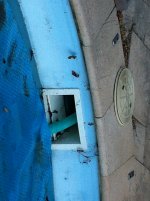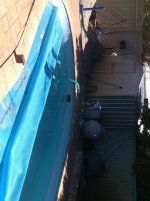The pool I look after is fibreglass IG and has concrete pavers built around it. The pavers are a limestone cream light yellow finish.
It was installed in 1998.
Bullnose Coping Pavers:
They were originally laid on a bed of limestone coloured mortar at the front bullnose edge and under the rear edge. The same mortar was placed between the underside of the pavers and the top edge of the fibreglass pool and is about 20mm thick. The mortar has cracked and fallen out in some places around the pool. This is allowing the sand under the pavers to be washed and blown into the pool. It is easy to see this happening as I can see a residue mark of the local fine black sand on the fibreglass under the coping tiles and well above the pool high water line.
95% of the coping pavers are still fixed down well at the front and back however they often have part of the mortar seal to the fibreglass missing. There are a few pavers that have come loose front and back and I will have to relay them with new mortar. However in the majority of cases I just need to replace the old cracked mortar seal.
The non coping pavers are simply laid on a bed of yellow sand.
Any ideas on the best way to do this and the best materials to use at the moment the options I have are:
Use the original mortar mix.
Sikaflex Pool
Selleys Landscape Construction adhesive
MortarFil
Expanding Foam
Tile over the gap.
The object is too:
Stop the sand
Neaten up the seal line
Reinforce the front of the coping pavers if needed ie stop them from moving downward if someone steps on the edge next to the water.
Refix the few Coping pavers that have come loose at the front bullnose and rear edges.
Your ideas appreciated:
Regards
Stuart Batt
It was installed in 1998.
Bullnose Coping Pavers:
They were originally laid on a bed of limestone coloured mortar at the front bullnose edge and under the rear edge. The same mortar was placed between the underside of the pavers and the top edge of the fibreglass pool and is about 20mm thick. The mortar has cracked and fallen out in some places around the pool. This is allowing the sand under the pavers to be washed and blown into the pool. It is easy to see this happening as I can see a residue mark of the local fine black sand on the fibreglass under the coping tiles and well above the pool high water line.
95% of the coping pavers are still fixed down well at the front and back however they often have part of the mortar seal to the fibreglass missing. There are a few pavers that have come loose front and back and I will have to relay them with new mortar. However in the majority of cases I just need to replace the old cracked mortar seal.
The non coping pavers are simply laid on a bed of yellow sand.
Any ideas on the best way to do this and the best materials to use at the moment the options I have are:
Use the original mortar mix.
Sikaflex Pool
Selleys Landscape Construction adhesive
MortarFil
Expanding Foam
Tile over the gap.
The object is too:
Stop the sand
Neaten up the seal line
Reinforce the front of the coping pavers if needed ie stop them from moving downward if someone steps on the edge next to the water.
Refix the few Coping pavers that have come loose at the front bullnose and rear edges.
Your ideas appreciated:
Regards
Stuart Batt



